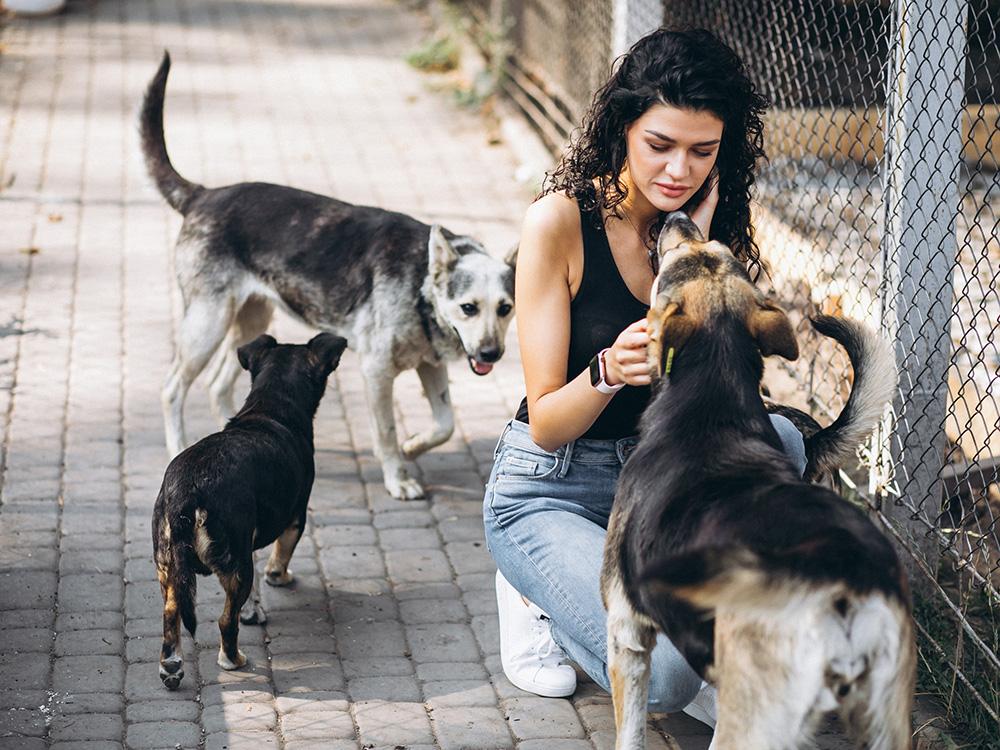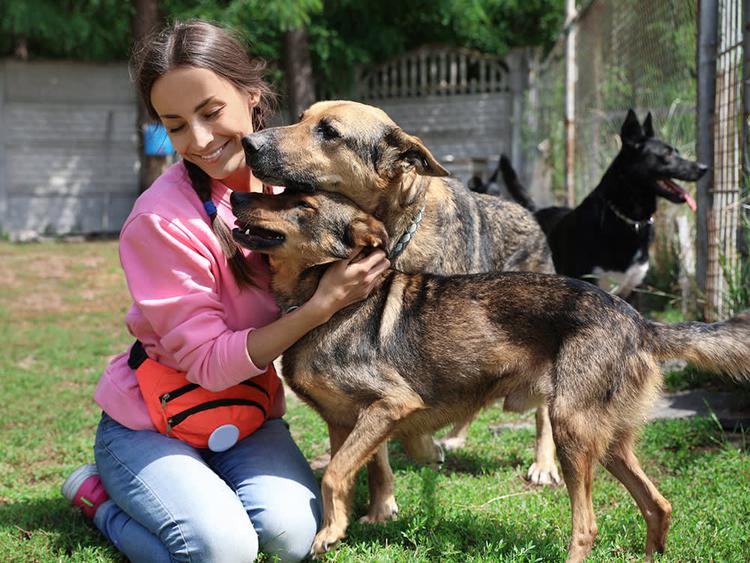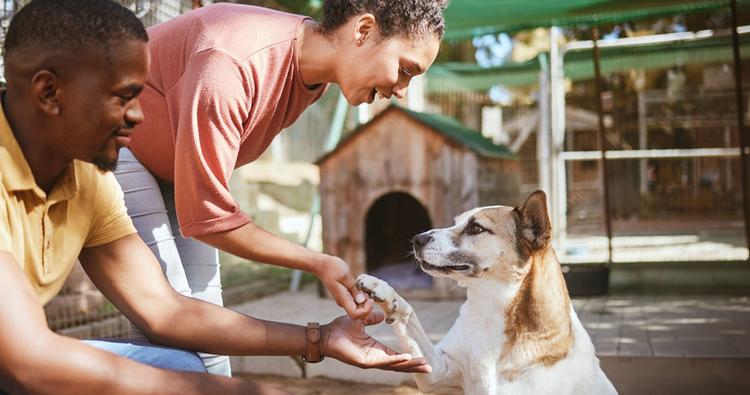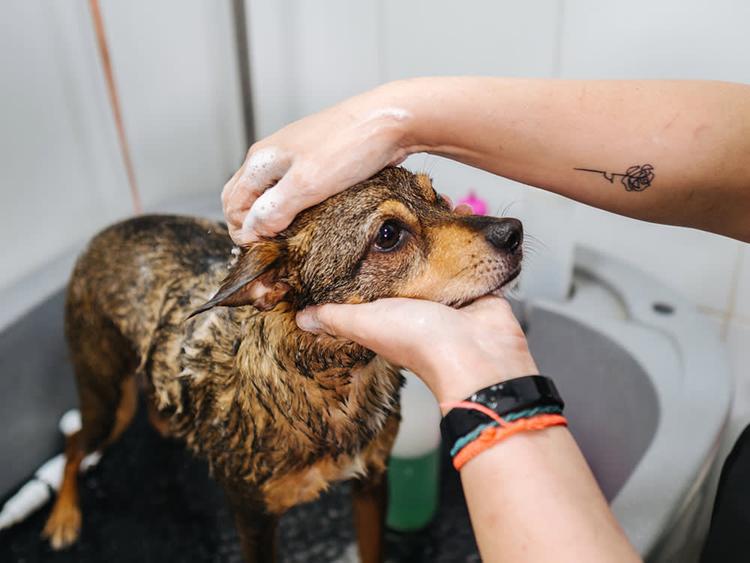by Savannah Admire, | December 13, 2023

PH888 / Shutterstock
Looking at online listings for adoptable pets can be fun, but when you’re ready to decide on a dog or cat to bring home, it’s time to choose an animal shelter to visit. You may be surprised by which animal in your local shelter captures your heart and feels like the perfect fit for your home and life. Taking the time to interact with a potential pet in person can help you find the right pet for you, as well as give you the opportunity to ask questions of shelter volunteers.
In this article:
When you feel prepared for your visit to an animal shelter, you can ease any anxiety you may have about shelter pet adoption and make sure that you’re ready for the commitment of pet parenthood.
Before visiting the animal shelter
While you can walk into an animal shelter any day they’re open, it helps if you can prepare yourself for the task of choosing a pet to adopt. Spend some time browsing online listings for your local shelter but don’t set your heart on a specific pet before you meet them. You may fall in love with a completely different animal at the shelter, so keep an open mind — and heart.
Consider what type of pet is the best fit
Before you visit a shelter, think about what you want in a pet.
Does your schedule allow for the needs of a dog, or is a cat a better fit?
Do you want a playful kitten or a chill older cat who will snuggle up and keep you company?
Do you have the time to train a young dog or is an older dog more suited as a pet who already knows the basics?
Shelter volunteers can help you find the right pet for you. They know a lot about the animal’s personalities and temperaments and can answer your questions to pair you with the right animal for your family and household.
Do some research
Read up on the animal shelter online and learn what to expect from their adoption process. Every shelter and rescue has their own steps to adopting a pet, so make sure you understand required fees and the information you’ll need to fill out an adoption application. Some shelters may require a home visit to make sure your environment is suitable for your chosen pet, while others may only require you to fill out a form and provide references.
Gather your supplies
While you likely won’t bring home a new pet after your dog shelter visit, it’s still a good idea to have your home prepped for their arrival. Make sure to pet-proof your house or apartment, putting away any cherished personal belongings to avoid damage. Go on a shopping trip to purchase all the supplies you’ll need for your new family member, such as food and water bowls, a collar and leash, toys, and treats.
Choose a time to visit
Many animal shelters are fine with walk-ins during their posted hours, but if you want to make sure a volunteer is available to speak with you, it doesn’t hurt to call and schedule an appointment. Find a time that works for you and anyone else you plan to bring along, whether that includes other members of your family or a friend for moral support. If you’re not able to visit the shelter in person, ask if there are virtual animal shelter visits available.
Bring your entire family
A visit to the animal shelter should be a family affair. Bring along everyone who will share in the responsibility of caring for the new pet, so you can make sure the animal is the right fit for everyone involved.
Taking children along when you visit an animal shelter can be a challenge, so it’s important to establish rules for their behavior before you go. Bringing your kids along can help them feel involved in the decision and get them excited about caring for a new pet.
During your visit to the animal shelter
Keep in mind that shelter staff and volunteers are often busy, and you may have to wait before you can spend time with a potential pet. Prepare for the animal shelter visit experience to be a noisy one, with excited shelter dogs barking about new people in their space.
1. Be patient and understanding
Animals may act differently in a shelter environment than they would in a home. Be patient and understand that a rescue dog or cat could be overwhelmed by new people, especially if you bring children with you. Give the animal space to approach you on their own terms, and remind children to pet them gently.
2. Ask questions
Don’t hesitate to ask shelter staff questions about your potential new pet, such as how the animal shelter cares for their animals and what training the pet may have had. This is your opportunity to learn about an animal’s health history, any behavioral issues, and how well they do with other animals. You can also ask about the next steps in the adoption process.
3. Take your time
As exciting as it is to visit a shelter and look for a new pet, don’t be disappointed if you don’t find the right dog or cat immediately. Your goal should be to connect with an animal who fits with your lifestyle. Be sure to take your time and be open to any animal in the shelter being the right one for you.
Tips for visiting an animal shelter
When you’re looking for a dog or cat to adopt, seeing all the animals in a shelter can be overwhelming. Keep these tips in mind as you visit your local shelter.
Spend time with the animals to get a clearer idea of what pet is best for you.
Keep an open mind and give every animal the chance to steal your heart.
Consider pets who are less likely to be adopted, such as senior animals.
Stay safe and pay close attention to any posted signs or notices.
Commonly asked questions
How can I ensure a successful shelter visit when looking to adopt a pet?
The best way to ensure a successful shelter visit is to be patient with both staff and animals, and take your time when choosing a new pet to adopt. Don’t hesitate to ask questions of shelter staff, whether about the animals or the adoption process — or both.
Can I donate to the shelter during my visit?
Yes, you can donate to the shelter during your visit. Shelters are always in need of supplies and financial support to help care for their animals. The staff will likely be more than happy to accept a donation during your visit.
References
Understanding Volunteerism in an Animal Shelter Environment: Improving Volunteer Retention

Savannah Admire
Savannah Admire is a writer, editor, and pet parent to two dogs and a cat. When she’s not writing, you can find her reading, playing Animal Crossing, or being an obnoxious nerd about her favorite movies and TV shows. She lives in Maryland, where she constantly debates whether or not to get a third dog.
Related articles

Shelters & Rescue
Are Shelter Pets Healthy?

Shelters & Rescue
What Is Animal Cruelty (And How to Report It)

Shelters & Rescue
Pet Shelter Myths: Facts About Adopting from a Shelter

Shelters & Rescue
Pet Adoption: How To Find A Pet Rescue?
Looking to adopt? Here are some helpful guidelines on finding a reputable pet rescue organization.

Shelters & Rescue
Stray Dog: What to Do If You Find a Stray Dog
Found a stray dog in your neighborhood? Read more to learn how to help safely.

Shelters & Rescue
What Is Trazodone, and Why Is it Given to Shelter Dogs?
The antidepressant can be a godsend to anxiety-ridden dogs, as well as to pups prone to getting sick in shelters

Shelters & Rescue
How Shelters Prepare Your Dog for Adoption

Shelters & Rescue
Help “Clear the Shelters” During the 2024 National Adoption Event
The campaign returns for the 10th straight year in August.

Shelters & Rescue
You Know What’s Really Scary? How Many Shelter Dogs Need Homes

Shelters & Rescue
It’s Adopt a Shelter Dog Month
Here’s how you can help a dog find a home this October.

Shelters & Rescue
No Dogs Left Behind: Rescuing Dogs from the Meat Trade
The nonprofit organization rescues and rehabilitates dogs from the global meat trade. Here’s how and why they do it.

Shelters & Rescue
How Petting Can Help Shelter Dogs Cope with Stress
This simple act can greatly benefit shelter pups (and humans, too).